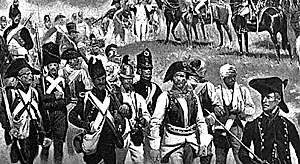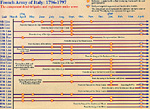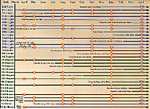 The glory and reknown that France's Army of Italy achieved during the famous campaign of 1796-1797 has become a permanent part of the Napoleonic legacy. However, the Army that Bonaparte fashioned and led was in actuality a constantly changing organization. The demi-brigades that fought their way across the Apennines from the Italian Riviera in the spring of 1796 did not necessarily march with the Army of Italy into Austria in 1797.
The glory and reknown that France's Army of Italy achieved during the famous campaign of 1796-1797 has become a permanent part of the Napoleonic legacy. However, the Army that Bonaparte fashioned and led was in actuality a constantly changing organization. The demi-brigades that fought their way across the Apennines from the Italian Riviera in the spring of 1796 did not necessarily march with the Army of Italy into Austria in 1797.
Tracing the career of any particular unit in this army can be difficult for a number of reasons. First, at the time that Bonaparte took command, the second amalgame, the process by which the old Royal units were to be combined with the units of the National Guard, had not been completed. In fact, the drawing of the lots (the assignment of new numbers to the demi-brigades), was not completed until 26 May, 1796, well after Bonaparte's campaign was underway.
Therefore, an order of battle for the Army of Italy in April does not compare easily to one from later in the campaign. For example, the 39th Demi-Brigade, which served in Augereau's Division, became the 4th Demi-Brigade. The 46th Demi-Brigade, which served with Serurier, later became the 39th Demi-Brigade.
Another Problem
Another problem can arise with the names and dates of battles. There were two battles at Dego (14 and 15 April, 1796), two battles of Lonato (31 July and 3 August, 1796), and two battles at Castiglione (3 August and 5 August, 1796). There were also two battles at Rivoli, the most well-known on 14-15 January, 1797, but also a lesser known affair in November between Vaubois and Davidovitch. (In this article, references to Lonato allude to the battle of 31 July. References to Rivoli allude to the 14-15 January battle.) Yet another problem in tracing units stems from the fact that Bonaparte moved the demi-brigades from division to division with alarming regularity (a habit Napoleon would continue as Emperor). Only a few demi-brigades served with the same division over the entire campaign. Bonaparte's primary reason for doing this was that he needed to constantly adjust the numbers of men to face the various threats posed by the Austrian attempts to relieve the besieged fortress of Mantua.
The demi-brigades were designated demi-brigades de bataille (line) or demi-brigade d'infanterie legere (light). [They are documented in this article using their anglicized names]. The line demi-brigades had a strength on paper of 3,000 men. The light demi-brigades had a strength of 1,500. However, these numbers were rarely achieved. For example the units forming the blockade of Mantua suffered greatly from sickness. In another example, on 31 October 1796, units at Mantua such as the 5th Line and the 12th Line were only at a fraction of their paper strength (818 and 710 men, respectively).
The cavalry regiments that served in Italy consisted mostly of light units of dragoons, chasseurs, and hussars, although two cavalerie de bataille or heavy cavalry regiments saw service with Bonaparte. The vast majority of these regiments did not reach Italy until the midsummer of 1796 or later.
As a result, the number of cavalry present was always low. Bonaparte usually grouped the regiments together into ad hoc units (mostly under Beaumont and LeClerc) for use in reconnaissance work. In spite of the fact that the Po Valley is an excellent area for cavalry operations, the mounted arm saw few opportunities to shine. This was because most of the major battles took place in rugged terrain along the edges of the valley floor. However, at Mondovi, Lodi, and Rivoli, the cavalry did play a decisive part in Bonaparte's victories.
The Guides
The Guides, Bonaparte's personal escort, were created in June of 1796 to protect Bonaparte and his staff after a couple of close calls with Austrian cavalry. The command of this elite unit went to Bessieres, who received the honor for his bravery at Borghetto on 30 May, when he single-handedly captured an enemy cannon. This particular unit is not shown in the list of demi-brigade/regimental histories contained in this article. The Guides, at best, numbered only a few hundred, and are represented in the numbers assigned to headquarters escort on the orders of battle.
The artillery available to Bonaparte during the first Italian campaign varied widely. At the beginning of the campaign, Bonaparte could muster only a tiny artillery train, but as more and more of northern Italy fell under French control, the Italian states were forced to hand over large amounts of artillery. In fact, Bonaparte's invasion of the Papal States, Modena, and the Romagna in June of 1796 was motivated by a need for siege artillery to use against Mantua as much as by political considerations.
 Map: Pursuit: 10 March to 6 April 1797 (Large very slow: 173K)
Map: Pursuit: 10 March to 6 April 1797 (Large very slow: 173K)
Map: Pursuit: 10 March to 6 April 1797 (Jumbo extremely slow: 369K)
It was unfortunate for Bonaparte that much of this heavy ordnance had to be dumped into the Mincio River or spiked as Wurmser approached Mantua with a relief force in late July 1796. The loss of this heavy artillery turned the siege of Mantua into a lengthy blockade, and therefore prolonged the campaign in Italy.
Color Charts

 The color "Units Under Arms" charts list all of the demi-brigades and regiments that fought with Bonaparte's Army of Italy in 1796-1797. A total of 27 line and 14 light demi-brigades, plus two provisional line demi-brigades, served in Italy. However, of these 43 infantry units, only 15 (10 line and 5 light) were with Bonaparte at the start of the campaign in March 1796.
The color "Units Under Arms" charts list all of the demi-brigades and regiments that fought with Bonaparte's Army of Italy in 1796-1797. A total of 27 line and 14 light demi-brigades, plus two provisional line demi-brigades, served in Italy. However, of these 43 infantry units, only 15 (10 line and 5 light) were with Bonaparte at the start of the campaign in March 1796.
Units under arms: Line infantry (Large Chart: very slow: 189K)
Units under arms Line infantry (Jumbo Chart: extremely slow: 561K)
Units under arms: Light infantry/Cavalry (Large Chart: very slow: 188K)
Units under arms: Light infantry/Cavalry (Jumbo Chart: very slow: 539K)
As the young general rapidly achieved victories, reinforcements were sent to him, increasing his infantry strength to 23 demi-brigades (14 line and 9 light) by June. A few more line demi-brigades were added over the summer and fall of 1796, and then, when ultimate victory on this front seemed within reach, 14 more demi-brigades (9 line and 5 light) were sent to Bonaparte from November 1796 through March 1797.
Similarly, although 19 cavalry regiments would ultimately fight in Italy, there were only five light regiments on hand at the beginning of the campaign. Three more were added soon after the battlefield successes in April, but except for these eight regiments and two more that arrived in July, Bonaparte had to wait until the end of the campaign for his cavalry command to reach double its original size.
Sources
Adlow, Elijah, Napoleon In Italy 1796-1797, Boston, 1948.
Colin, Jean, Etudes sur la Campaigne de 1796-97 en Italie, Paris, 1898.
Fabry, G., Rapports historiques des regiments de l'armee d'Italie pendant la campagne de 1796-1797, Paris, 1905.
Lynn, John A., The Bayonets of the Republic -- Motivation and Tactics in the Army of Revolutionary France, 1791-1794, Urbana and Chicago, 1984.
Phipps, Colonel R. W., The Armies of the First French Republic and the Rise of the Marshals of Napoleon I, Vols. 1 through 5, London, 1926.
Wilkerson, Spenser, The Rise of General Bonaparte, London, 1930.
More Army of Italy 1796-1797:
-
Instrument of Victory
Map: Pursuit: 10 March to 6 April 1797 (Large very slow: 173K)
Map: Pursuit: 10 March to 6 April 1797 (Jumbo extremely slow: 369K)
Unit Profiles: Line Infantry
Unit Profiles: Light Infantry
Unit Profiles: Cavalry
French Revolutionary Line Officer
French Army Amalgames
Units under arms: Line infantry (Large Chart: very slow: 189K)
Units under arms Line infantry (Jumbo Chart: extremely slow: 561K)
Units under arms: Light infantry/Cavalry (Large Chart: very slow: 188K)
Units under arms: Light infantry/Cavalry (Jumbo Chart: very slow: 539K)
The 200th Anniversary Series on Napoleon in Italy
-
First Installment: Side Road To Immortality
Second installment: The Supporting Cast
Third installment: Maintaining the Initiative
Fourth installment: General Bonaparte Defends His Conquests
Fifth installment: Napoleon Turns Defeat into Victory
Sixth installment: One Final Victory: Rivoli
Seventh installment: Endgame: The Pursuit to Final Victory
Eighth installment: Instrument of Victory: Army of Italy
Back to Table of Contents -- Napoleon #9
Back to Napoleon List of Issues
Back to MagWeb Master Magazine List
© Copyright 1997 by Emperor's Press.
This article appears in MagWeb (Magazine Web) on the Internet World Wide Web.
The full text and graphics from other military history magazines and gaming magazines are available at http://www.magweb.com